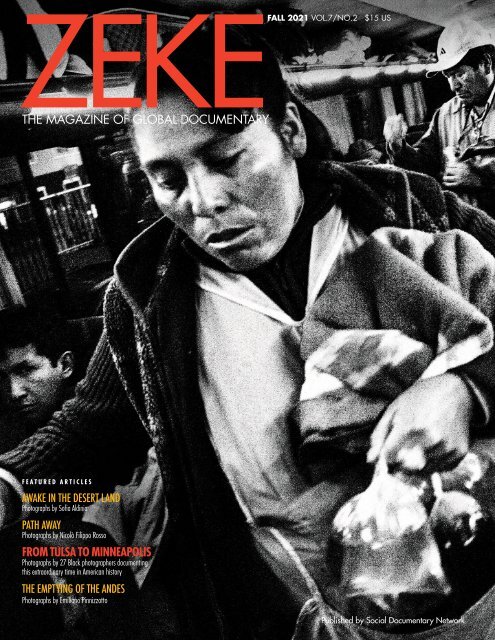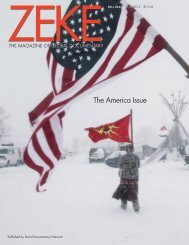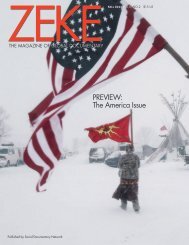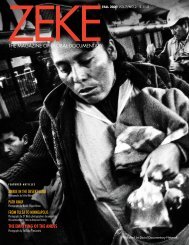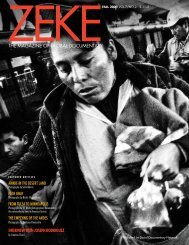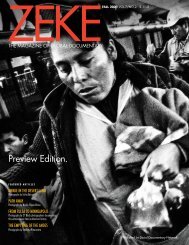ZEKE Magazine: Fall 2021, From Tulsa to Minneapolis: Documenting the Long Road to Justice
Photographs by 27 Black photographers documenting this extraordinary time in U.S. history.
Photographs by 27 Black photographers documenting this extraordinary time in U.S. history.
You also want an ePaper? Increase the reach of your titles
YUMPU automatically turns print PDFs into web optimized ePapers that Google loves.
<strong>ZEKE</strong>FALL <strong>2021</strong> VOL.7/NO.2 $15 US<br />
THE MAGAZINE OF GLOBAL DOCUMENTARY<br />
FEATURED ARTICLES<br />
AWAKE IN THE DESERT LAND<br />
Pho<strong>to</strong>graphs by Sofia Aldinio<br />
PATH AWAY<br />
Pho<strong>to</strong>graphs by Nicolò Filippo Rosso<br />
FROM TULSA TO MINNEAPOLIS<br />
Pho<strong>to</strong>graphs by 27 Black pho<strong>to</strong>graphers documenting<br />
this extraordinary time in American his<strong>to</strong>ry<br />
THE EMPTYING OF THE ANDES<br />
Pho<strong>to</strong>graphs by Emiliano Pinnizzot<strong>to</strong><br />
Published by Social Documentary <strong>ZEKE</strong> FALL Network <strong>2021</strong>/ 1
FROM TULSA TO MINNEAPOLIS<br />
Pho<strong>to</strong> by Joshua Rashaad<br />
McFadden<br />
After <strong>the</strong> last speech at <strong>the</strong><br />
Commitment March Rally on<br />
August 28, 2020, thousands<br />
of people flooded <strong>the</strong> streets of<br />
Washing<strong>to</strong>n, D.C., <strong>to</strong> protest<br />
police brutality in America.<br />
2 / <strong>ZEKE</strong> FALL <strong>2021</strong>
PHOTOGRAPHING THE LONG ROAD TO JUSTICE<br />
<strong>ZEKE</strong> FALL <strong>2021</strong>/ 3
FROM TULSA TO MINNEAPOLIS: PHOTOGRAPHING THE LONG ROAD TO JUSTICE<br />
Several consistent <strong>the</strong>mes arise across<br />
<strong>the</strong> thousands of images documenting<br />
<strong>the</strong> last year of racial justice<br />
protests in <strong>the</strong> United States— <strong>the</strong><br />
raised Black power fist; a surge of<br />
civilian bodies facing off against<br />
a line of s<strong>to</strong>ny-faced police forces; eyes<br />
raised <strong>to</strong> <strong>the</strong> camera in triumphant challenge<br />
of <strong>the</strong> powers that be. Each of <strong>the</strong>se<br />
poignant moments draw from long his<strong>to</strong>ries<br />
of pho<strong>to</strong>graphy on <strong>the</strong> American struggle<br />
for justice within a country whose deeply<br />
embedded racism spans centuries built of<br />
settler colonization and <strong>the</strong> enslavement of<br />
Black people.<br />
An especially horrific part of that long<br />
his<strong>to</strong>ry of racial terror and subjugation in<br />
America is <strong>the</strong> 1921 <strong>Tulsa</strong>, Oklahoma massacre<br />
of Black residents by a white mob.<br />
While many Black Americans have long<br />
held <strong>the</strong> memory of that deadly night and<br />
<strong>the</strong> several preceding years of white mob<br />
violence that erupted across <strong>the</strong> nation,<br />
few pho<strong>to</strong>graphs exist <strong>to</strong> bear ongoing<br />
witness <strong>to</strong> <strong>the</strong> death and destruction. In <strong>the</strong><br />
decades since, however, Black Americans<br />
have utilized <strong>the</strong> camera’s evidentiary<br />
power as a <strong>to</strong>ol in <strong>the</strong> twin struggles <strong>to</strong><br />
humanize Black lives and depict racial<br />
injustice. The evisceration of <strong>Tulsa</strong>’s prosperous<br />
Black community and <strong>the</strong> 2020<br />
racial justice protests that represent <strong>the</strong><br />
largest social justice movement in U.S.<br />
his<strong>to</strong>ry are separated by nearly 100 years,<br />
serving as troubling markers of how little<br />
progress has been made on this long road<br />
<strong>to</strong> justice. Yet, <strong>the</strong> influx of visual s<strong>to</strong>rytelling<br />
by those whose lives are held in <strong>the</strong><br />
balance and social media’s access <strong>to</strong> a<br />
rapt global audience offers new hope that<br />
justice might yet be realized.<br />
Since Black Lives Matter’s 2013 beginnings<br />
as a hashtag following <strong>the</strong> 2013<br />
shooting death of Black teenager Trayvon<br />
Martin, <strong>the</strong> movement gained steam as<br />
both a social media campaign and a<br />
series of national protests in <strong>the</strong> wake of<br />
each Black person killed by police brutality.<br />
It’s vital <strong>to</strong> understand how much this<br />
movement (and many o<strong>the</strong>r contemporary<br />
social justice efforts) owes <strong>to</strong> <strong>the</strong> wide<br />
circulation of visual evidence online. While<br />
such egregious acts of racial violence and<br />
police brutality have been rampant since<br />
<strong>the</strong> advent of American policing, it is <strong>the</strong><br />
increasing presence of digital cameras that<br />
have ushered in an era where racism can<br />
be documented and <strong>the</strong>refore demand fur<strong>the</strong>r<br />
reckoning. As BLM builds on <strong>the</strong> visual<br />
rhe<strong>to</strong>ric of Civil Rights Movement pho<strong>to</strong>graphy,<br />
<strong>the</strong> relationship between street-level<br />
activism and <strong>the</strong> power of <strong>the</strong> camera is<br />
increasingly revealed.<br />
The collection of 23 pho<strong>to</strong>graphs on<br />
<strong>the</strong>se pages is drawn from over 500<br />
images submitted by pho<strong>to</strong>graphers who<br />
answered <strong>the</strong> call <strong>to</strong> share <strong>the</strong>ir visual<br />
interpretations of <strong>the</strong> <strong>Long</strong> <strong>Road</strong> <strong>to</strong> <strong>Justice</strong>.<br />
Importantly, <strong>the</strong> work is primarily made<br />
by Black pho<strong>to</strong>graphers whose lived<br />
experiences of racial injustice and respect<br />
for Black lives is tangibly felt across <strong>the</strong><br />
pho<strong>to</strong> essay. <strong>From</strong> Brian Branch-Prices’s<br />
intimate look at Black musicians <strong>to</strong> Kenechi<br />
Unachukwu’s We Still Here, a picture of<br />
Black resilience emerges. Donald Black<br />
Jr.’s loving ode <strong>to</strong> Black childhood symbolizes<br />
exactly what we fight for: a future<br />
where <strong>the</strong> threat of police brutality against<br />
our children, our mo<strong>the</strong>rs, our fa<strong>the</strong>rs and<br />
bro<strong>the</strong>rs is a thing of <strong>the</strong> past.<br />
The work <strong>to</strong> realize that future, however,<br />
is far from over. Even as <strong>the</strong>se images of<br />
Black life compel <strong>the</strong> world <strong>to</strong> recognize<br />
<strong>the</strong> shared humanity of all people, <strong>the</strong>re<br />
remains a stark disconnect between <strong>the</strong><br />
realities visualized by our pho<strong>to</strong>graphy<br />
and <strong>the</strong> widespread realization of social,<br />
political, and economic reform. The<br />
struggle for racial justice continues and we<br />
lift our cameras as we steady our resolve,<br />
ready <strong>to</strong> meet <strong>the</strong> call wielding our choice<br />
of weapons.<br />
—Tara Pixley<br />
Program Credits<br />
Chair:<br />
Lisa DuBois<br />
Jurors:<br />
Laylah Amatullah Barrayn<br />
Lisa DuBois<br />
Anthony Barboza<br />
Eli Reed<br />
Jamel Shabazz<br />
4 / <strong>ZEKE</strong> FALL <strong>2021</strong>
Best-of-Show Award<br />
Donald Black Jr.<br />
A Day No One Will Remember<br />
A collection of images created by Donald<br />
Black Jr. over <strong>the</strong> past 10 years. After returning<br />
home <strong>to</strong> Cleveland, Ohio, he started creating<br />
images that only an insider could see<br />
and began making images that represented<br />
his perception of his reality. Seeing himself<br />
and where he came from has influenced<br />
an obsession <strong>to</strong> pho<strong>to</strong>graph children in his<br />
community.<br />
<strong>ZEKE</strong> FALL <strong>2021</strong>/ 5
FROM TULSA TO MINNEAPOLIS: PHOTOGRAPHING THE LONG ROAD TO JUSTICE<br />
Above<br />
Pho<strong>to</strong>grapher: Titus Brooks Heagins<br />
Exhibit Title: Where <strong>the</strong> Sidewalk Ends<br />
This project represents a visual dialog<br />
that interrogates <strong>the</strong> lives of those who<br />
live in <strong>the</strong> margins of society.<br />
Caption: Brittany and Brianna<br />
Right <strong>to</strong>p<br />
Pho<strong>to</strong>grapher: Brian Branch-Price<br />
Exhibit Title: Rhythm and Praise, an<br />
Epic Journey<br />
This project reflects <strong>the</strong> expressions,<br />
thoughts and actions of a people, of a<br />
culture and of a folk who love <strong>to</strong> sing,<br />
dance, shout, give, teach, preach, cut a<br />
step all in <strong>the</strong> name of gospel music.<br />
Caption: Percy Bady, Newark, New<br />
Jersey<br />
Right below<br />
Pho<strong>to</strong>grapher: Teanna Woods Okojie<br />
Exhibit Title: Black Boy Joy<br />
Black Boy Joy is a series of multiple<br />
images spanning from 2013 <strong>to</strong> <strong>2021</strong><br />
depicting young African youth and<br />
young men in various environments<br />
experiencing pure joy.<br />
6 / <strong>ZEKE</strong> FALL <strong>2021</strong>
Above<br />
Pho<strong>to</strong>grapher: Brian Branch-Price<br />
Exhibit Title: BLM: The Third<br />
Expressing <strong>the</strong> frustrations of an oppressed<br />
community reacting <strong>to</strong> social injustices, economic<br />
apar<strong>the</strong>id, Jim Crow, over-policing,<br />
lynching, inhumanity, during peaceful and<br />
confrontational protest in New York, New<br />
Jersey, Philadelphia, Richmond, and D.C.<br />
Caption: Livia Rose Johnson, 20, march<br />
organizer during a <strong>Justice</strong> for George Floyd<br />
protest and rally in New York on June 4, 2020<br />
Left<br />
Pho<strong>to</strong>grapher: Raymond W. Holman, Jr.<br />
Exhibit Title: COVID-19 in Black America<br />
Environmental portraits of Black and brown<br />
skin people with first-hand experience of<br />
COVID-19 – having recovered, lost family<br />
members, been mentally challenged by<br />
social isolation, and figuring out how <strong>to</strong><br />
adjust and make a new pathway.<br />
Caption: A Prince<strong>to</strong>n University student<br />
experiencing a year of online classes and<br />
isolation due <strong>to</strong> COVID-19, but becoming a<br />
stronger human being through this challenge.<br />
<strong>ZEKE</strong> FALL <strong>2021</strong>/ 7
FROM TULSA TO MINNEAPOLIS: PHOTOGRAPHING THE LONG ROAD TO JUSTICE<br />
Above<br />
Pho<strong>to</strong>grapher: Lisa DuBois<br />
Exhibit Title: MAAFA: The Great African<br />
Tragedy<br />
A term meaning “Great Disaster” in Swahili,<br />
MAAFA ceremonies honoring ances<strong>to</strong>rs<br />
became part of African-American culture<br />
at <strong>the</strong> onset of slavery — <strong>the</strong> African<br />
Holocaust — and continue <strong>to</strong>day, honoring<br />
<strong>the</strong> generations that lived and died as slaves<br />
and bringing catharsis.<br />
Caption: A woman prepares for a ritual<br />
using a bell. It is believed ances<strong>to</strong>rs can hear<br />
this sound.<br />
Right<br />
Pho<strong>to</strong>grapher: Imari DuSauzay<br />
Exhibit Title: We <strong>the</strong> People<br />
Started by Joe of Saint James Joy, <strong>the</strong>se<br />
Block Party sessions in <strong>the</strong> heart of Brooklyn’s<br />
Clin<strong>to</strong>n Hill celebrated <strong>the</strong> community<br />
without separations, embracing all who came<br />
<strong>to</strong> share <strong>the</strong>ir joy in collective dance free<br />
from imposed constructs of social stress and<br />
all “isms,” healing through a collective of We<br />
The People.<br />
Caption: FLIGHT<br />
8 / <strong>ZEKE</strong> FALL <strong>2021</strong>
Left<br />
Pho<strong>to</strong>grapher: Cheryle Galloway<br />
Exhibit Title: Out of Many?<br />
Pho<strong>to</strong>graphing as an archaeologist<br />
discovering things left behind by a lost<br />
civilization, removing social constructs<br />
used as <strong>to</strong>ols <strong>to</strong> divide us in <strong>the</strong> hope <strong>to</strong><br />
breakdown all walls <strong>to</strong> mutuality, Out of<br />
Many? asks, how does America heal <strong>to</strong><br />
become one nation?<br />
Caption: “How much time do you want<br />
for your ‘progress’”? James Baldwin. The<br />
White House, Washing<strong>to</strong>n, D.C.<br />
Lower Left<br />
Pho<strong>to</strong>grapher: LeRoy W. Henderson<br />
Exhibit Title: Expressions Against Racism<br />
and Oppression in America<br />
These pho<strong>to</strong>graphs represent growing<br />
public expression against racial injustice<br />
and oppression in America. People of all<br />
ages are beginning <strong>to</strong> become more vocal.<br />
Significantly, young people in growing<br />
numbers are taking <strong>the</strong> leadership in this<br />
movement for change.<br />
Above<br />
Pho<strong>to</strong>grapher: Collette Fournier<br />
Exhibit Title: Taking <strong>the</strong> Struggle <strong>to</strong> <strong>the</strong><br />
Streets—Black Lives Always Mattered<br />
After learning my people were once slaves<br />
as a youngster, I have been on a visual<br />
journey <strong>to</strong> document my people in <strong>the</strong><br />
Diaspora. Working on a series enables me<br />
<strong>to</strong> revisit and expand upon my ideas, knowing<br />
that <strong>the</strong> s<strong>to</strong>ry rarely ends.<br />
Caption: Suffern, NY; Die-In for Kimani<br />
Gray, 2013. Willie Trotman, President of<br />
NAACP Spring Valley, Community activist<br />
Ken Mercer and <strong>the</strong> student community at<br />
a Die-In protest in Rockland County, NY.<br />
<strong>ZEKE</strong> FALL <strong>2021</strong>/ 9
FROM TULSA TO MINNEAPOLIS: PHOTOGRAPHING THE LONG ROAD TO JUSTICE<br />
Above<br />
Pho<strong>to</strong>grapher: Shoun Hill<br />
Exhibit Title: Protests 2020<br />
These are pho<strong>to</strong>graphs from 2020 of <strong>the</strong> protests<br />
surrounding <strong>the</strong> murders of unarmed African-<br />
Americans by police officers in <strong>the</strong> USA.<br />
Caption: A participant holds a sign during a vigil and<br />
coming <strong>to</strong>ge<strong>the</strong>r for George Floyd, Sunday, May 31,<br />
2020, in Inwood Park in Manhattan.<br />
Right<br />
Pho<strong>to</strong>grapher: Kevin Bernard Jones<br />
Exhibit Title: March on Washing<strong>to</strong>n 2020—A<br />
People’s Perspective<br />
The 2020 March on Washing<strong>to</strong>n for racial justice and<br />
police reform organized by Reverend Al Sharp<strong>to</strong>n and<br />
<strong>the</strong> National Action Network after <strong>the</strong> public murder<br />
of George Floyd just months before by a <strong>Minneapolis</strong><br />
police officer. Held fifty-seven years after Martin<br />
Lu<strong>the</strong>r King Jr.’s 1963 “I Have a Dream.”<br />
Bot<strong>to</strong>m<br />
Pho<strong>to</strong>grapher: Khary Mason<br />
Exhibit Title: It is a Difficult Time <strong>to</strong> Convict a Hero<br />
In this series, Mason explores media’s influence upon<br />
society’s perceptions of law enforcement, and <strong>the</strong><br />
silence vs. duty of Black officers in America.<br />
Caption: Chasing freedom...<br />
10 / <strong>ZEKE</strong> FALL <strong>2021</strong>
Left<br />
Pho<strong>to</strong>grapher: Deja Nycole<br />
Exhibit Title: Black & Dangerous<br />
A collaborative project utilizing poetry,<br />
portraiture, and reportage <strong>to</strong> redefine <strong>the</strong><br />
way Black people are perceived because of<br />
stereotypes.<br />
Caption: Ed Ross, 21, Accokeek, Maryland<br />
Above<br />
Pho<strong>to</strong>grapher: Thaddeus Miles<br />
Exhibit Title: It Took Me <strong>to</strong> My Knees!<br />
Caption: Tired & Ready<br />
Top:<br />
Pho<strong>to</strong>grapher: Burroughs Lamar<br />
Exhibit Title: National Action Network<br />
(NAN) March on Washing<strong>to</strong>n<br />
Rev. Al Sharp<strong>to</strong>n’s NAN organization<br />
brought <strong>to</strong>ge<strong>the</strong>r masses of people of<br />
varying ethnicities in a peaceful march that<br />
included a speech by Martin Lu<strong>the</strong>r King<br />
Jr.’s son MLK,III, leaving a spirit of hopefulness<br />
that <strong>the</strong> tragic deaths and injustices<br />
afflicting Africans Americans for centuries<br />
will cease <strong>the</strong> need for future marches.<br />
Caption: Martin Lu<strong>the</strong>r King, Jr. Memorial.<br />
Washing<strong>to</strong>n, D.C.<br />
<strong>ZEKE</strong> FALL <strong>2021</strong>/ 11
FROM TULSA TO MINNEAPOLIS: PHOTOGRAPHING THE LONG ROAD TO JUSTICE<br />
12 / <strong>ZEKE</strong> FALL <strong>2021</strong><br />
Top<br />
Pho<strong>to</strong>grapher: Tara Pixley<br />
Exhibit Title: Our Streets<br />
Taken across multiple 2020 protests<br />
in Los Angeles, <strong>the</strong>se pho<strong>to</strong>s speak <strong>to</strong><br />
<strong>the</strong> true spirit of <strong>the</strong> Black Lives Matter<br />
movement: peaceful showings of solidarity,<br />
community action, and expressions of<br />
democratic public assembly in <strong>the</strong> face of<br />
COVID-19 and racism’s twin pandemics.<br />
Caption: People stared with open admiration<br />
at a Black man on horseback who<br />
rode in circles carrying <strong>the</strong> Pan-African<br />
flag.<br />
Above<br />
Pho<strong>to</strong>grapher: Kenechi Unachukwu<br />
Exhibit Title: We Still Here<br />
People from all ages and ethnicities led by<br />
young Black men and women congregated<br />
at <strong>the</strong> capi<strong>to</strong>l <strong>to</strong> voice <strong>the</strong>ir frustrations<br />
about a system that has led <strong>to</strong> <strong>the</strong> wrongful<br />
death of many Black citizens at <strong>the</strong><br />
hands of <strong>the</strong> police.<br />
Right<br />
Pho<strong>to</strong>grapher: Michael Young<br />
Exhibit Title: When Will it be Enough.<br />
2020—A Year of Resistance<br />
Caption: Black Issues 1619 -2019. Image<br />
taken at <strong>the</strong> Black Lives Matter Harlem<br />
Street Mural which had been vandalized<br />
and is under repair.
Top<br />
Pho<strong>to</strong>grapher: Sheila Pree<br />
Bright<br />
Exhibit Title: #1960Now: Jim<br />
Crow 2.0<br />
Growing up in <strong>the</strong> Jim Crow<br />
era, my parents never spoke of<br />
<strong>the</strong>ir experiences until Trayvon<br />
Martin’s death by police brutality.<br />
My mo<strong>the</strong>r said, “I didn’t<br />
want you <strong>to</strong> hate white people. I<br />
can’t believe I would see <strong>the</strong> day<br />
that Black people’s oppression<br />
still exists.”<br />
Caption: Statue of Dr. Martin<br />
Lu<strong>the</strong>r King Jr. by Jamaican-born<br />
Basil Watson installed in <strong>2021</strong>,<br />
Atlanta, GA.<br />
Lower Left<br />
Pho<strong>to</strong>grapher: Eva Woolridge<br />
Exhibit Title: We are Not Free<br />
Until We are All Free<br />
An exhibition that discusses<br />
<strong>the</strong> relationship between all<br />
marginalized groups who are in<br />
<strong>the</strong> fight <strong>to</strong> live freely as <strong>the</strong>y<br />
are, with images from marches<br />
for Black Lives, Palestine, and<br />
Black Trans Lives. Because we<br />
all matter.<br />
Caption: True Patriot.<br />
Above<br />
Pho<strong>to</strong>grapher: Reece T.<br />
Williams<br />
Exhibit Title: On <strong>the</strong><br />
Anniversary of My Profound<br />
Confusion<br />
My earnest attempt <strong>to</strong> not only<br />
chronicle <strong>the</strong> 2020 marches<br />
for Black lives and living, but<br />
<strong>to</strong> understand how and why<br />
this moment, out of all <strong>the</strong><br />
moments, was chosen as “a<br />
reckoning,” and how only now?<br />
<strong>ZEKE</strong> FALL <strong>2021</strong>/ 13
Subscribe <strong>to</strong> <strong>ZEKE</strong><br />
$25.00* for two issues/year<br />
Includes print and digital<br />
*Additional costs for shipping outside <strong>the</strong> US.<br />
Subscribe <strong>to</strong> <strong>ZEKE</strong> magazine and get <strong>the</strong> best of<br />
global documentary pho<strong>to</strong>graphy delivered <strong>to</strong> your<br />
door, and <strong>to</strong> your digital device, twice a year. Each<br />
issue presents outstanding pho<strong>to</strong>graphy from <strong>the</strong><br />
Social Documentary Network on <strong>to</strong>pics as diverse<br />
as <strong>the</strong> war in Syria, <strong>the</strong> European migration crisis,<br />
Black Lives Matter, <strong>the</strong> Bangladesh garment industry,<br />
and o<strong>the</strong>r issues of global concern.<br />
But <strong>ZEKE</strong> is more than a pho<strong>to</strong>graphy magazine.<br />
We collaborate with journalists who explore<br />
<strong>the</strong>se issues in depth —not only because it is important<br />
<strong>to</strong> see <strong>the</strong> details, but also <strong>to</strong> know <strong>the</strong> political<br />
and cultural background of global issues that require<br />
our attention and action.<br />
Click here <strong>to</strong> find out how »<br />
www.zekemagazine.com/subscribe<br />
Contents of <strong>Fall</strong> <strong>2021</strong> Issue<br />
Awake in <strong>the</strong> Desert Land<br />
Pho<strong>to</strong>graphs by Sofia Aldinio<br />
Path Away<br />
Pho<strong>to</strong>graphs by Nicolò Filippo Rosso<br />
<strong>From</strong> <strong>Tulsa</strong> <strong>to</strong> <strong>Minneapolis</strong>: Pho<strong>to</strong>graphing <strong>the</strong><br />
<strong>Long</strong> <strong>Road</strong> <strong>to</strong> <strong>Justice</strong><br />
Pho<strong>to</strong>graphs by 27 Black pho<strong>to</strong>graphers documenting this<br />
extraordinary time in American his<strong>to</strong>ry<br />
The Emptying of <strong>the</strong> Andes<br />
Pho<strong>to</strong>graphs by Emiliano Pinnizzot<strong>to</strong><br />
Migration from <strong>the</strong> Nor<strong>the</strong>rn Triangle<br />
by Daniela Cohen<br />
Interview with Joseph Rodriguez<br />
by Caterina Clerici<br />
Pho<strong>to</strong>graphy & Social Change<br />
by Emily Schiffer<br />
Book Reviews<br />
Edited by Michelle Bogre


